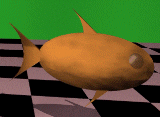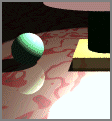


POV-RAY is a public-domain renderer that I enjoy using. This page shows you some of my renderings, and gives links to the main POVRAY page and other, more accomplished users' pages.
The Persistence Of Vision Ray-tracer is a public-domain 3D rendering system that allows any (sufficiently tenacious) user to create professional-quality ray-traced images. It offers a sophisticated modelling and shading language that is fairly easy to learn and use, but is exceedingly flexible. Newer versions of POV-RAY support state-of-the-art graphical and modelling effects including radiosity.
 To use POV-RAY,
you merely create a file in the pov language that describes your scene,
then run the rendering engine! A scene can take 2 minutes or 2 days or
even longer to render. Versions of POV-RAY are available for essentially
all types of computers and operating systems.
To use POV-RAY,
you merely create a file in the pov language that describes your scene,
then run the rendering engine! A scene can take 2 minutes or 2 days or
even longer to render. Versions of POV-RAY are available for essentially
all types of computers and operating systems.
The current version of POV-Ray is 3.1, and it is available for UNIX, Linux, Macintosh, and PC/Windows platforms. For more information about POV-RAY, visit the official web site.
Here is a representative sampling of some of the renderings I've done; they are roughly in chronological order, newest first. (Click on the little image to download the full version.)
![]() This is a test rendering I did of the output of a program to simulate
accretion of randomly-fired random-sized spheres - this particular
example consists of 1700 little spheres. The object at right is
a quadric shape called a piriform.
This is a test rendering I did of the output of a program to simulate
accretion of randomly-fired random-sized spheres - this particular
example consists of 1700 little spheres. The object at right is
a quadric shape called a piriform.
[testacc5 JPEG - 82K]
 This is an image of a geography classroom that I entered in the May 1997
Internet Ray-Tracing Competition.
I worked very hard on this one, and I think it turned out okay. It uses
a lot of fairly tricky POV-Ray techniques to achieve some of the
texture effects. Also, every floorboard in the floor is unique,
generated by a Perl script. It scored
middle-of-the-pack in the competition.
This is an image of a geography classroom that I entered in the May 1997
Internet Ray-Tracing Competition.
I worked very hard on this one, and I think it turned out okay. It uses
a lot of fairly tricky POV-Ray techniques to achieve some of the
texture effects. Also, every floorboard in the floor is unique,
generated by a Perl script. It scored
middle-of-the-pack in the competition.
[geography JPEG - 96K]
 An experiment with several POV-Ray features to make a cool
countertop scene. All textures are original except the wood on the
sticks and the wood below the counter. If anybody knows how to fix my
refraction problem with the cellophane, please let me know.
An experiment with several POV-Ray features to make a cool
countertop scene. All textures are original except the wood on the
sticks and the wood below the counter. If anybody knows how to fix my
refraction problem with the cellophane, please let me know.
[countertop4 JPEG - 74K]
 An illustration for the manual cover
An illustration for the manual cover
This is a quick rendering I did to be a cover for my copy
of the POV-Ray 3.0 documentation. [cover3 JPEG - 51K]
![]() A major effort with POV-RAY 3beta - a full set of chess
pieces on a chess board, partly lit by a burning
match. [chess1 JPEG - 81K]
A major effort with POV-RAY 3beta - a full set of chess
pieces on a chess board, partly lit by a burning
match. [chess1 JPEG - 81K]
![]() Another POV-RAY 3beta modelling attempt - this shows
Another POV-RAY 3beta modelling attempt - this shows
Spaceman Spiff's flying saucer near an unknown
planet. [spiff3 GIF - 49K]
![]() A cool ship's wheel with some words cut into it.
A cool ship's wheel with some words cut into it.
Probably my best POV-RAY 2.2 image. [wheel3 JPEG - 171K]
![]() Another early effort of a little reflecting pool
Another early effort of a little reflecting pool
near a hillock [pool1 JPEG - 50K]
![]() An early effort with POV-RAY 2.2, this one is a
An early effort with POV-RAY 2.2, this one is a
room with some objects in it and a
picture of Yoshi on the wall.
[room1 JPEG - 50K]
All of these images were rendered on two different Pentium PCs using POV-Ray 2.2, 3.0b6, and 3.0, and 3.0 for Windows95. Most of these images have been scaled down from their original rendered sizes. The longest rendering was the geography classroom at 61 hours, and the quickest was the manual cover at about 2 hours. Source code for any of these can be obtained from me via email.
Here are the official site links:
POV-RAY is popular tool and lots of folks have rendering pages with POV stuff and information on them. Most of them are much cooler than this small effort. Here are some of my favorites:
There is also a newsgroup devoted to ray-tracing, comp.graphics.rendering.raytracing.
All ray tracings on the page were modeled and rendered by Neal Ziring, © 1995-97. You are welcome to employ any of these images in any form, as long as proper attribution is preserved. Source code for these scenes available upon request. Thank you.
[Ziring MicroWeb Home] [Neal Ziring] [Julie Ziring] [Sign Guestbook]
This page written by Neal Ziring, last modified 8/7/99.